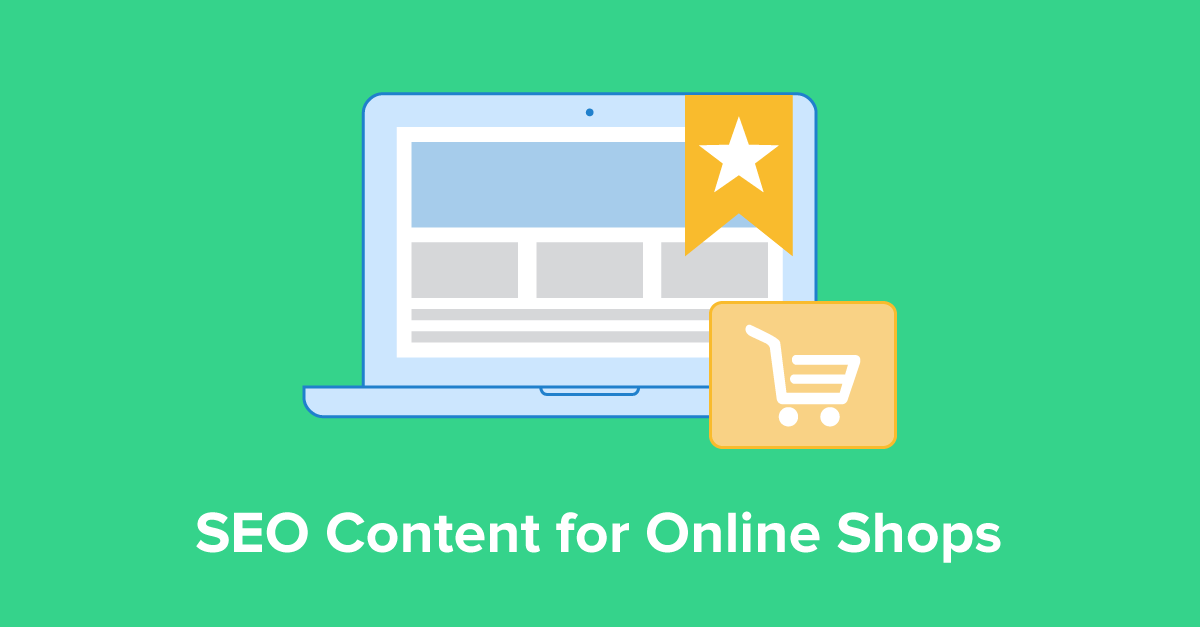
Are you tired of hearing: Content is king?
Wouldn’t you rather learn about what kind of content you actually need for your online store and how to create it?
Then, you’ve come to the right place.
In this guide, Alexander Rus, founder of the Austrian SEO agency Evergreen Media, explains…
- what an SEO-focused content strategy entails and why it’s so important
- what types of content an online shop needs
- how to find the right keywords
- what matters when you do create content
- which tools will help you through the process
- which common mistakes to avoid
(Note: This guest post was originally published in German and was translated into English by Seobility. Click here for the original version).
If you’re in a hurry, you can skip ahead to:
Table of Contents
- 1 What Is an SEO-Focused Content Strategy for Online Stores?
- 2 Essential Content Types for Online Stores
- 3 Keyword Research and the AIDA Model: What Kind of Content Does My Store Need?
- 4 The Fundamentals of UX-Content Creation for Online Stores
- 5 Often Forgotten Task: Link Building For Online Stores
- 6 Tools: How to Make Your Content Strategy Easier
- 7 Common Mistakes: How Come My Strategy Isn’t Working?
- 8 Conclusion: Matching Search Intent + Data-Driven Strategy = Successful Content
At this point, you’re probably wondering: What’s the point of all of this effort? Why do I need a specific content strategy when all I really want are more sales?
To answer these questions, it’s best to start from the beginning.
What Is an SEO-Focused Content Strategy for Online Stores?
An SEO-focused content strategy is based on content that’s exactly tailored to the needs of Google users.
These needs can be summarized under the umbrella term “search intent”. In other words, what is the specific intention behind the search query? (What does the person searching the web expect to get from their Google search?)
Search Intent, SEO, Data & Content: The Big Picture
The goal of an SEO-focused content strategy is to use keyword data to create the right content for every phase of the decision-making and purchasing process.
In fact, there’s really no other way to go, because without the data for keyword search volume, click rates, etc., it would be difficult if not impossible to determine what content users actually want to see.
So, what does this have to do with search engine optimization?
Quite a lot, actually:
- By analyzing data, you can determine what users expect from their Google searches.
- Once you know what users want, you’ll create content that speaks to users’ needs instead of solely concentrating on your sales figures.
- Google’s algorithm will determine that your website’s content matches the users’ search intent and is therefore, helpful to the users.
- Finally, Google’s search engine will classify your website as relevant, and as a result, it will appear higher up in search results.
In principle, data-driven content strategies with a focus on SEO isn’t so different from classic “offline” shopping.
Imagine this. You go into an electronics store because you’re looking for a new laptop. Your visit to the store could be driven by different motivations.
- You want to see a specific model.
- You want to get advice.
- You only want to look around. You’re not in a hurry to buy a device.
In each of these scenarios, you come into the store with different needs and intentions.
SEO Content for Online Stores: More Visibility Through Matching Content
This is exactly how users interact with online stores: Each visit follows its own pattern and search intent.
In the physical store, you solicit advice. This advice helps you in the information-gathering and decision-making process, without trying to convince you of anything. The goal isn’t to twist your arm but rather to inform you.
The same thing happens when you write SEO content. Because it is specifically tailored to this decision-making process – based on keyword data – Google gives your content more visibility.
Therefore, if your online store serves the searchers’ intent, it will become more visible in search engines.
And the more people who discover your store through a Google search, the better chances you have of getting new customers. With SEO-focused content, your store is also visible even when there is no intention to buy. You cover the whole customer journey by offering commercial and non-commercial content equally.
Essential Content Types for Online Stores
A well-established online store normally consists of:
- a home page
- diverse category pages
- even more product pages
- required pages for imprint, privacy, etc.
- non-commercial content area (blog, knowledge base, etc.)
Within the context of our SEO-content strategy, the category pages and the non-commercial content are important.
Commercial Content
The home page, as well as the category and product pages, are commercial in character. However, traditional marketing language is no longer sufficient for these pages.
Take a look at a few category pages of successful online shops in your niche. Do they only contain product listings or is there also additional content? The more informative you make your commercial content, the better it is for your potential customers.
More information can be provided by:
- purchasing advice – customer support and FAQs
- internal links to additional content
- an overview of additionally relevant products, categories, themes
Here’s an example: This category page for laptops and notebook computers first gives a product overview. This is followed by a brief explanation of everything you need to know for finding the perfect laptop.

Source: https://www.staples.com/Laptops/cat_CL167289
As you can see, a number of secondary keywords are covered – but more on secondary keywords later.
Non-Commercial Content
With non-commercial content, you pick up people who are searching Google without a concrete intention to buy. They’ll come into contact with your brand at an early stage of the decision-making process.
Non-commercial content may include:
- advice (instructions, checklists, …)
- tools with a specific purpose (calculator, etc.)
This section addresses any of the sub- and marginal issues that have anything even remotely to do with your industry. You can then link to commercial content internally – provided this cross-reference makes real sense thematically.
Traditionally, non-commercial content consists of guides or advice. For example, this web hosting provider covers a diversity of informational keywords.
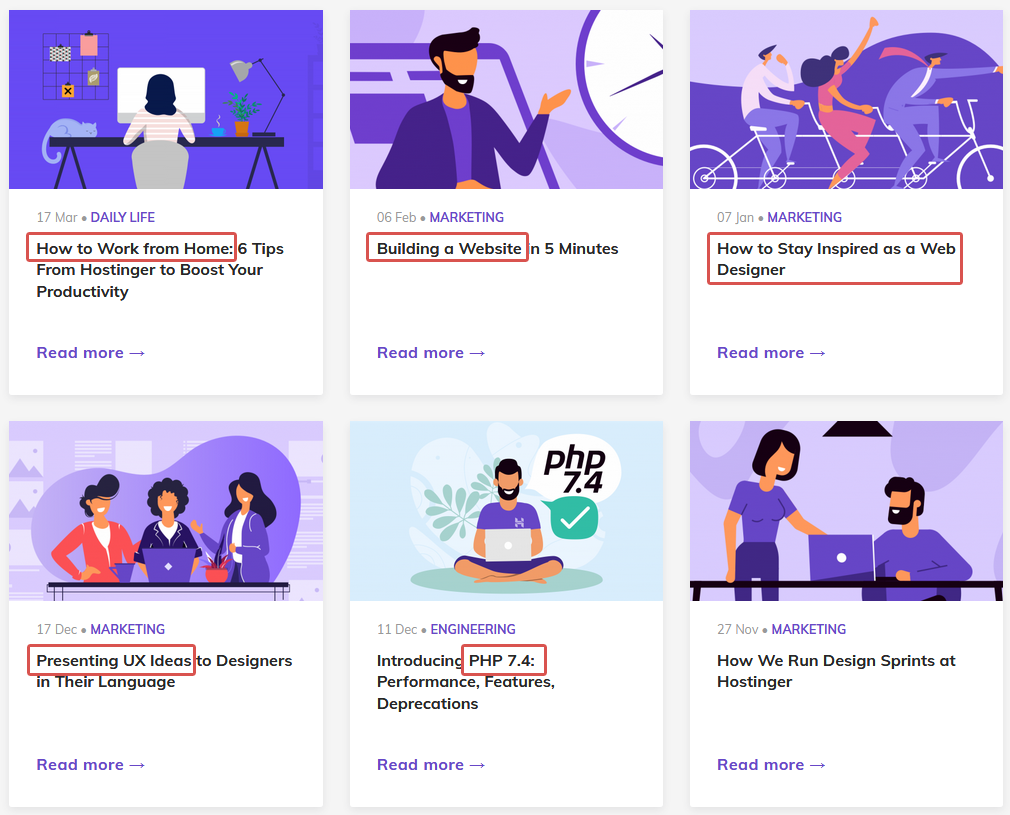
Source: https://www.hostinger.com/blog/
Linkable assets also fall into the non-commercial category. They are a special case because they not only bring traffic to your site, but they can also improve the link profile of your store.
Special Case: Linkable Assets
This category consists of content that has high potential to get backlinks from other websites. However, in order for you to get as many industry-relevant pages as possible to refer back to your site, the content has to be impressive. In other words, offer very specific value.
Infographics and tools are proven methods. Below, you’ll find a practical example.
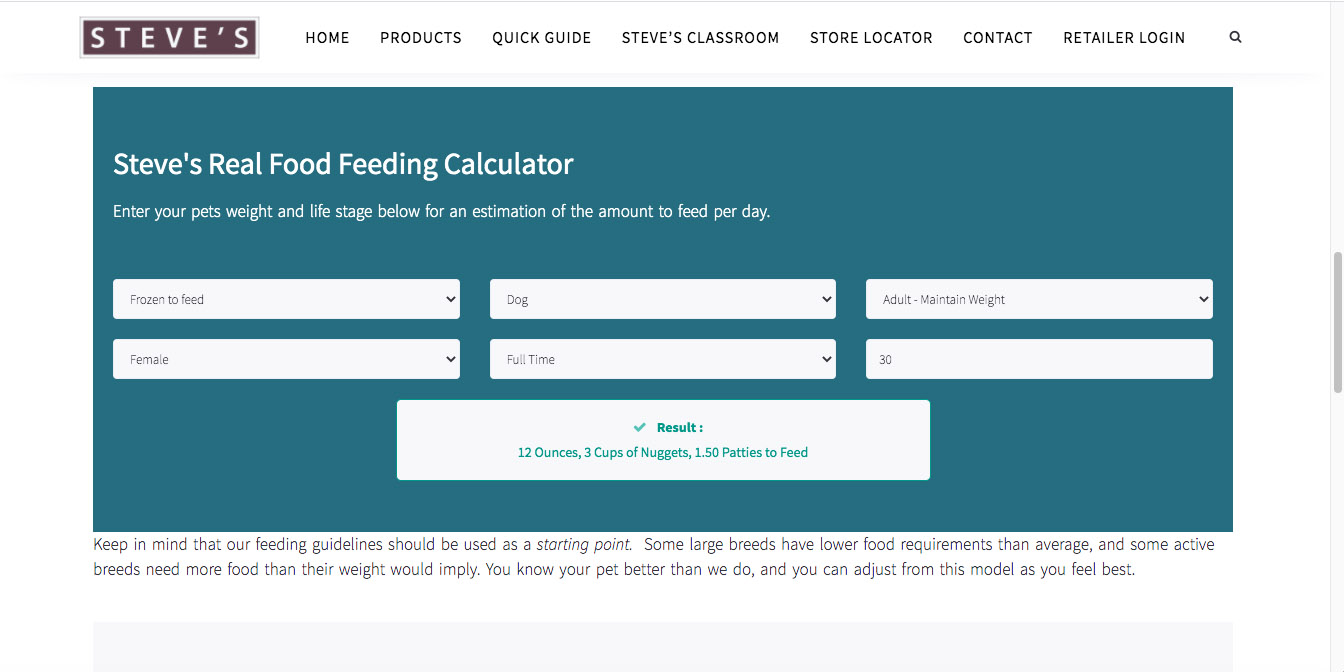
Source: https://www.stevesrealfood.com/quick-guide/feeding-calculator/
With this tool, you can calculate the amount of food your dog or cat needs to eat to remain healthy. These calculations are based on your pet’s ideal weight, your pet’s activity level and other factors. The calculator is provided by Steve’s Real Food, a raw pet food company.
This is a clever addition to a pet food site. It engages pet owners by offering them something practical to use: in this case, a food calculator. It’s an example of a non-commercial asset that could drive sales in an organic way.
Another benefit: Other websites that cater to the pet care industry also link to this calculator.
And why not? Who wouldn’t want to put a useful tool in their readers’ hands that provides them with real value in the process?
At the end of the day, non-commercial content isn’t just important because it enables you to cover all of the facets of the customer’s journey. It’s also important because it plays a critical role in link building.
At this point, only one question remains: How do I know which keywords to use at which stage?
Glad you asked. Enter keyword research, stage left.
Keyword Research and the AIDA Model: What Kind of Content Does My Store Need?
The AIDA advertising formula plays a central role in an online store’s keyword selection process. The acronym stands for:
- Awareness
- Interest
- Desire
- Action
Each interaction on or with a website is connected to one of these phases in the decision-making process.
Time for a practical example!
Example: AIDA and Keywords in Practice
Every Google search arises from a specific problem situation. This initial situation is what is known as the awareness phase. That is, someone becomes aware of a problem and wants to solve it.
Let’s follow an exemplary fictional character named John on his AIDA search. Here’s the scenario. A friend has invited him to play a round of squash. John likes this idea, but the powers-that-be will hardly let him into the squash hall with his dirty sneakers.
| Phase | Possible Search Terms | Situation |
| Awareness | sport shoes men | Indoor shoes are needed. John wanted to buy them for a long time anyway. And sports shoes are sports shoes, aren’t they? |
| Interest | sport shoes squash, squash shoes what to look for, indoor squash shoes | Apparently, there are differences… like does John specifically need indoor squash shoes? Or will normal sneakers work? And what about the shoes’ traction? Sheesh. This decision isn’t as easy as he thought… |
| Desire | best squash shoe, squash shoe asics comparison, squash shoes best 2020 | The shortlist has been made. But which pair is the perfect one? If a decision is worth making, it’s worth making right. |
| Action | salming hawk gunmetal red | Salming Hawk it is! John orders a pair. |
This is only a rough example, but still you can see that each section requires a completely different approach and specific keywords.
Keyword Research: Finding the Right Search Terms
In order to develop a keyword strategy, we must know which topics are in high demand. We need to additionally estimate how well these search terms convert.
More specifically, we want to find the search terms that are most likely to convert to cash immediately. In this case, the keyword phrases “squash shoes best 2020″ or the question from the interest phase are both examples that would work.
Ideally, this creates a cycle: Higher sales figures lead to more brand awareness. This, in turn, increases sales.
Slight disclaimer: The topic of keyword research is too big to cover it in this article. If you want to know more about this topic, we recommend you to read this guide on how to do keyword research by Seobility.
How Can I Implement a Keyword Strategy?
You have several ways to convert your chosen keywords into content that will help your online store to get more traffic:
- Create new pages that cover topics you have not yet covered on your site and optimize those pages for search.
- Improve your site’s structure, i.e., create topic clusters.
- Open up your product line to expand into new markets.
- Build upon existing content (i.e. FAQs) so that it includes more long-tail keywords.
Naturally, it could happen that you uncover a keyword that hasn’t been covered yet and which is similar to content you already have. What do you do then?
Content Overlap Score: When Does Your New Content Require Its Own Pages?
If you are unsure if you need a new page for a keyword, you can look at the term’s SERP overlap percentage.
This value indicates how much the content overlaps which is ranking for two separate searches. The whole point is that these search terms are often worded very similarly.
Here’s how you find the overlap percentage: Open two browser tabs and insert one of the search terms in each tab and then start your Google search.
How many of the Top 10 results are identical? If it’s more than 50%, then you don’t need an extra page on your website. Ten to 20% is the line, according to AJ Kohn of Blind Five Year Old.
Overlap Score: An Example
Let’s say a start-up that sells an environmentally-friendly cleaning agent would like to use the keywords “eco friendly cleaning” and “eco friendly cleaning agents” in its content strategy. The formulation is only slightly different here – but can both terms be covered with one content piece?
The SERPs show the following results for “eco friendly cleaning”:
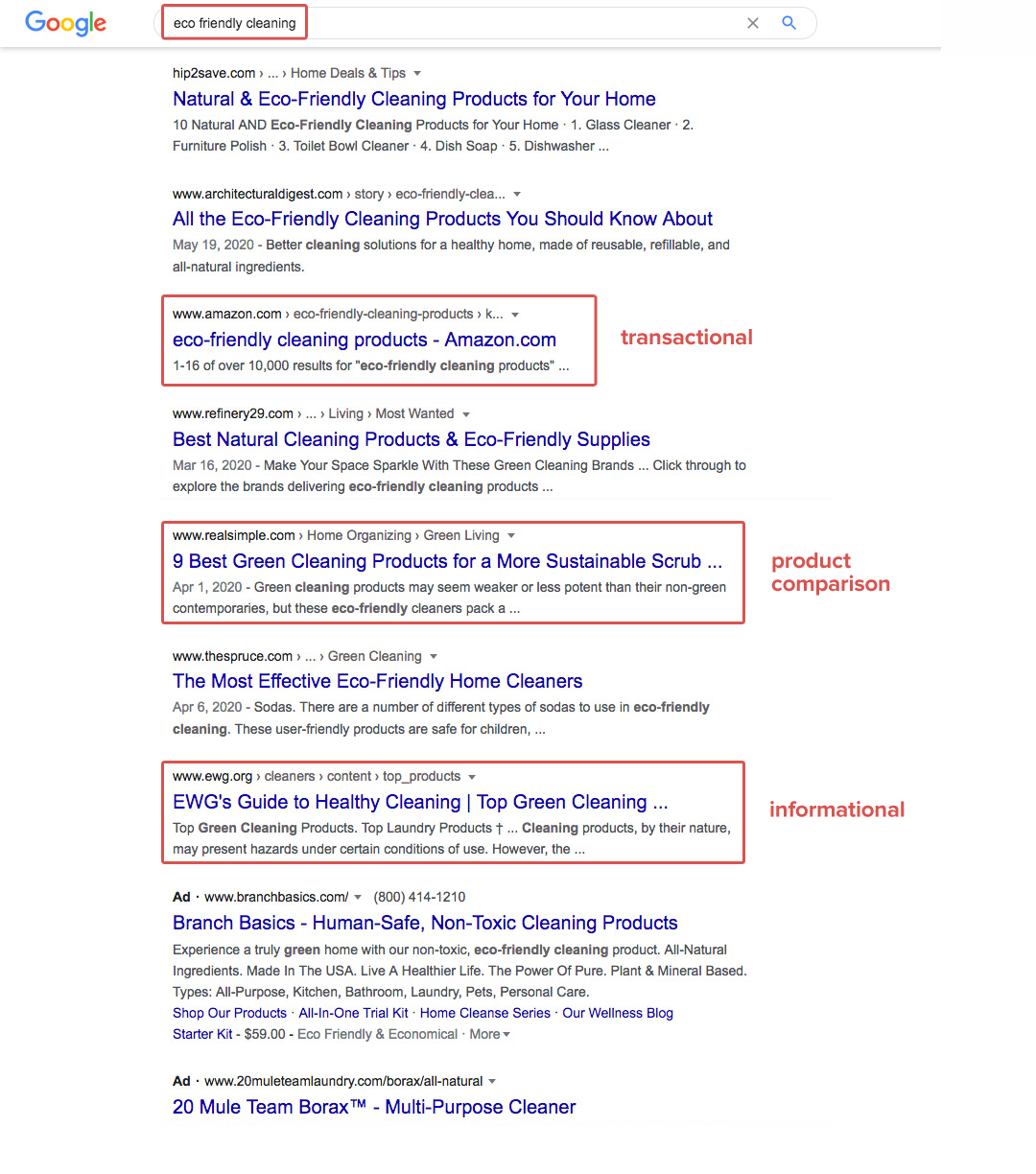
For “eco friendly cleaning agents” the results look quite different:
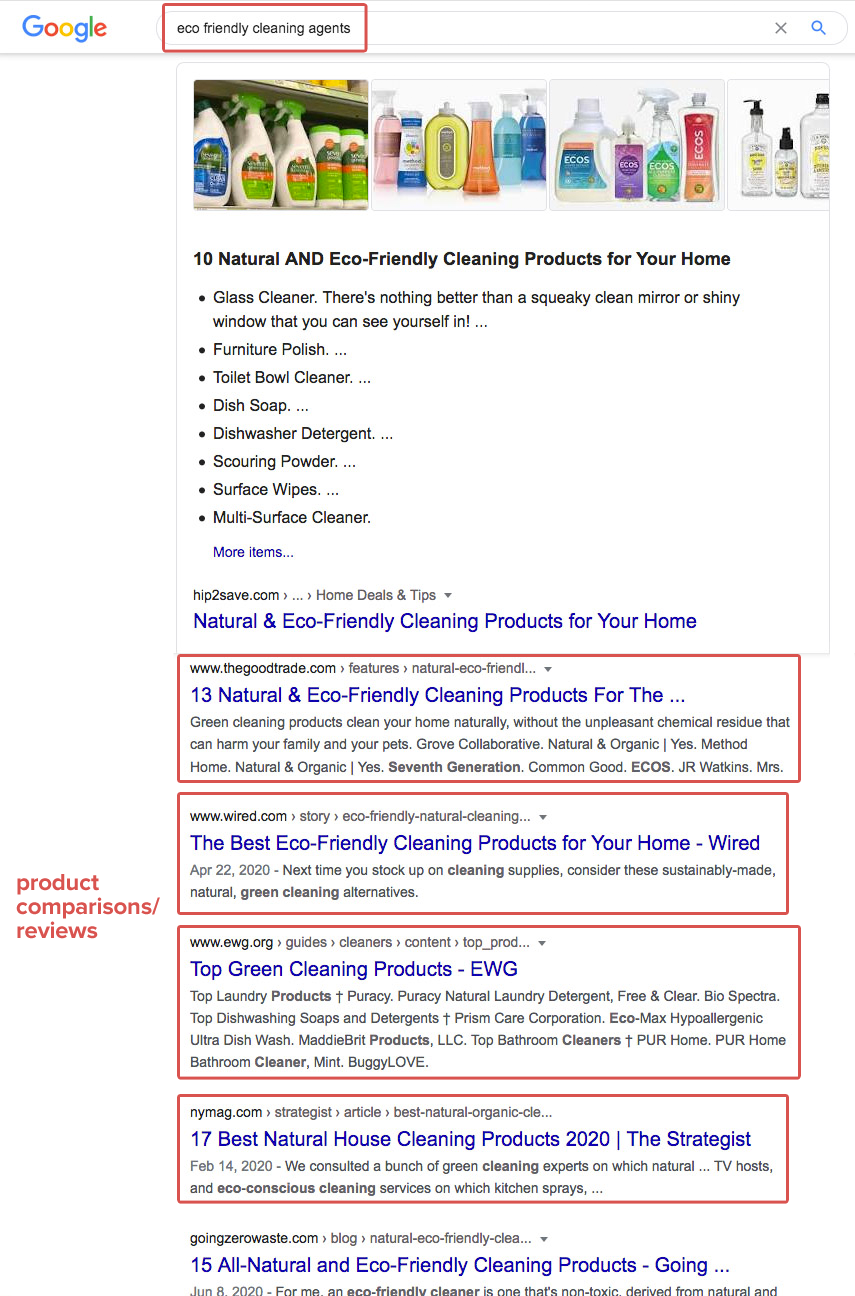
An important thing to note here is that Hip2Save.com is represented in both searches. However, the similarity between the two searches ends with Hip2Save.com.
It’s also important to point out that in the first example, the search results on Google seem to serve different search intents, whereas the second search is clearly about product comparisons.
In other words, the overlap between the two searches is low. In light of this, you should create two separate content pages, one for “eco friendly cleaning” and one for “eco friendly cleaning agents.”
If you now know which pages need to be matched with which content type and which keywords, the next step is content creation.
The Fundamentals of UX-Content Creation for Online Stores
Google users are impatient creatures. We all want to quickly find what we’re looking for. That makes it all the more important to keep an eye on search intent and usability when you’re creating content – here’s an overview!
What Distinguishes User-Centered Content?
User-friendly content saves the user two important things: time and nerves. The more accessible your content is, the better the user experience. UX-optimized content is characterized by:
- Readability: Formulate short sentences; avoid passive constructions and too much technical jargon, etc.
- UX Writing: Each textual element must help users move intuitively through the website.
- Beautiful design: Enhance your texts with pictures or video material, bulleted lists, tables, infographics, etc.
- Help: The content must be helpful in some way. This can be the purchase advice, the product comparison, the test report as a decision aid, etc., etc., etc.
Search Intent: The Key Factor for More Visibility
Search intent – i.e. the specific intention behind a search term – is your most important clue. Only when it is honored can your shop find and keep its visibility on the web.
Basically, the users’ search intent can fall into three main categories:
| Search Intent/ Category | What Does This Mean? | Examples |
| Transactional | A purchase is imminent or planned; the user is close to the conversion. | iPhone 11 Pro buy used |
| Informational | The informational phase is not necessarily followed by a transaction. | organic seal of approval comparison |
| Navigational | The user is searching for a specific website, brand or person. | Barnes & Noble online store, Facebook login |
Here comes the big BUT: Search intent doesn’t remain static. It happens every so often that existing content stops corresponding with the original intent of a particular keyword. Google also recognizes this, and sooner or later, the page gets pushed down in the search results.
Additionally, very few search queries fit only one category. Mixed intent is much more common, i.e., various secondary meanings are associated with a keyword.
And what happens once the keywords and search intent have been clarified and the tailored content has gone online?
Often Forgotten Task: Link Building For Online Stores
There’s one thing that often falls by the wayside: SEO-focused content marketing doesn’t just happen on your website. Link building is an equally relevant part of your strategy because high-quality backlinks help you to establish your website as an authority in your niche.
As it is with keyword research, it’s impossible to fully cover the topic of link building here. In light of that, we’d like to suggest the link building guide by Seobility or several other link building articles.
At this point, we only want to share one essential tip to remember for doing link building for your online shop: Non-commercial content is the way to go!
As a matter of principle, backlinks should not refer to category pages because that will make the Google algorithm suspicious faster than a New York minute.
Focus on linkable assets and rely on additional internal links for commercial content. Don’t worry: With internal links, you don’t have to worry that Google will punish you for over-optimization.
Tools: How to Make Your Content Strategy Easier
Finally, in this section you will find a few tools that you can use as you develop an SEO content strategy.
Keep this in mind: We want to focus on the data, i.e., we want reliable information about search volumes.
At the same time, we must keep an eye on the users’ search intent. What content is in demand? What developments are emerging in terms of keyword coverage?
The following tools can help you answer these questions…
SEO/ Keyword Tools
There are a few tools for keyword research that you can use for free such as keyword-tools.org or answerthepublic.com. Another particularly useful tool is alsoasked.com, as it shows all user questions relating to the keyword. You can (and should) find the exact same questions in Google’s SERPs (see below), but with the tool you can be sure that you really won’t miss anything.
However, a small disclaimer: You should know that free tools might not show you concrete numbers as is the case with the paid version of the tools. If you are serious about keyword research and if you want to get meaningful data, then investing in one or two tools is definitely worth it.
Google SERPs
When it comes to competitor analysis, you should look at every detail on the search results page. Are there featured snippets? Is there video content in the top results? How many words does the competition use? (Tip: With Seobility’s TF*IDF tool, you can easily check which word count is used on the top ranking pages.)
Common Mistakes: How Come My Strategy Isn’t Working?
The strategy is planned. Your first content pieces are ready or revised… And yet, even after a long wait, nothing is happening. What could be the reason for this? Perhaps, it’s due to one of the following errors in your e-commerce SEO content.
Thin Content
Too little time and/ or too little subject knowledge often leads to shallow content. This content helps no one and accordingly, does not garner positive user signals.
Let’s go back to the sports shoe example: Imagine you need some purchasing advice. You scroll the content of an online shop. You come across tips, like: “The shoe shouldn’t be too tight nor too wide.”
Would you feel like your questions have been answered? Hardly.
In content creation you must always go a step farther. How do you know when a shoe is too tight? When is it too wide? How much does a shoe expand when worn? If you don’t invest this effort, you’ll be quick to resort to thin content.
Low Conversion
Your traffic is skyrocketing. Your sales figures? Not so much.
In this case, you need to significantly improve your conversion rates. Your visitor numbers are irrelevant – or nearly so. At the end of the day, you want your site visits to convert to sales.
Take a closer look at your content: Do you need to restructure something so that users can find your content more quickly? Is there a problem with usability? Is your call-to-action not clear enough?
Keyword Cannibalization
This effect can happen when two URLs are optimized to rank for the same keyword and the same search intent. These two pages sabotage each other.
The tricky thing about this is that cannibalization happens unintentionally and is often just the result of overly eager optimization attempts. You will find this problem explained in detail e.g. on Search Engine Journal.
In light of this, it is all the more important to plan your content strategy thoroughly and to record it in a dedicated document. The longer a project runs, the easier it is to lose track of things.
Static Content
It’s worth saying again: Search intent is not fixed. “Stay tuned” is the slogan of the day. Do a content audit at least once a year and check if or where you need to adjust something:
- Take a look at the top 10 pages that are ranking for your main keywords.
- Are the top 3 search results covered by eCommerce sites? Then you can still compete with your category page and only need to update your content.
- Do the pages on top positions provide mainly informational content? That means the search intent has changed. You now need to rely more on non-promotional content: Create blog posts, for example.
For very large stores, this approach is tedious. It may be more useful to evaluate the analytics data first: How long do people stay on the page? What are the bounce rates, entries etc.? You can then go through a manual SERP check.
Conclusion: Matching Search Intent + Data-Driven Strategy = Successful Content
Online stores get approximately 37.5% of their traffic from search engines – above all from Google. So the sooner you make sure that your shop gains visibility on Google, the better!
To do that, you need both commercial and non-commercial content, as well as data from keyword and analytics tools, in order to have a deep understanding of the users’ search intent. Only when you can deliver this kind of content, content that people search for, will Google’s algorithm reward you.
Important: Don’t expect miracles from the content alone – your online store must also offer excellent usability and an appealing product range.
Finally, pay attention to the four most important tips for an SEO-focused content strategy!
- Continuously evaluate and optimize your content.
- Invest enough time in content that, on first glance, doesn’t concern itself with sales. Instead, cover all of the points of contact in the customer journey in order to strengthen your brand.
- Pay attention to mixed search intent. It’s seldom when a search query comes with only a single intention.
- Use your non-commercial content for linkable assets to expand the link profile of your shop.
3 thoughts on “SEO Content for Online Shops”
I liked this post, since it helped me in SEO development, thanks
Interesting and useful stuff to read. Thanks to Seobility, our webshop is now 99 per cent SEO-optimized. I truly appreciate your service.
Wow, congratulations on that great achievement! It’s great to hear that you’re happy with Seobility. 🙂